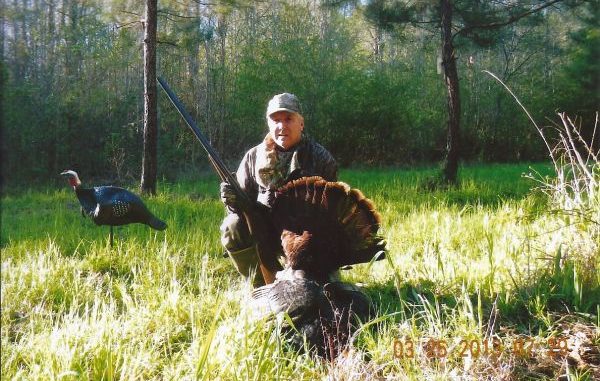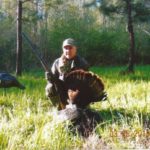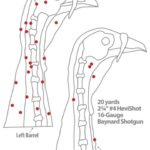
Old sweet 16 does the trick
When you hear “Phfffffftt,” you know a strutting tom is close and it is time to get ready.
I grew up in North Louisiana, the south end of Webster Parish just above the northwestern boundary of Bienville Parish to be more exact. We lived about a mile from Lake Bistineau, and needless to say I spent many days on the lake, fishing and duck hunting.
I also spent time in the fields and woods around our house. When I wasn’t playing ball, I was fishing and hunting.
The habitat was beautiful: mixed pine/hardwood forests filled with oaks and hickories, pasture land and fence rows that were grown up with good cover. In the late ’50s some of the fields were still growing cotton that was actually still hand-picked.
There were plenty of squirrels, rabbits, doves and quail, and a growing deer population.
Unfortunately, the wild turkey was missing. A little restocking had been done in parts of the parish, but for us there was no gobbling to hear in the spring or toms strutting in the open pastures to see.
Had there been some turkeys, we would have been pursuing them.
Dad was a wing shooter, mainly doves and ducks. When he came home from WWII, he brought home a Bayard double-barreled 16-gauge shotgun. He had bought it to shoot skeet during his off time, when he wasn’t flying a B-17 bomber in preparation to go overseas and join in the action.
His squadron did not go to war. They were on the East Coast waiting to fly over to England when the war ended.
He must have done a good bit of skeet shooting, because he was a dead shot with the little double barrel.
This was the gun that I grew up hunting with; I started off by shooting doves in the fields next to the house. Yes, I must admit that a few non-doves fell victim to the gun on those days when doves were not flying.
My first fox squirrel was bagged on a school-day afternoon while I was sitting under a hickory tree.
But it was dad who could do the damage with it. I remember our last duck hunt together on Bistineau. We were in the pirogue that he had built, and it was one of those foggy mornings and the ducks were flying low.
We could hear them squealing long before they flew over, which gave us time to get ready — and with just two shots he had his two woodies. I think it was just a three duck limit that year.
When my wife and I moved to Southeast Louisiana after college and I went to work for the Department of Wildlife & Fisheries, I discovered our woods were full of wild turkeys, and it wasn’t long before I was hunting them.
I hunted in the open woods of St. Helena Parish prior to the timber companies leasing their land, and enjoyed some good hunting in the Chipola area. I also hunted on private land in East and West Feliciana parishes, and of course on Pearl River WMA. The turkey hunting on this tract of public land was some of the best to be had in the state in the mid- to late-’80s. I think the current LDWF turkey biologist Jimmy Stafford will confirm that statement.
It never worked out that dad could come down and make a hunt with me, and by the time the turkey restoration in Northwest Louisiana had finally worked, his health was just too bad for us to go make a hunt.
Dad enjoyed duck hunting, making a setup with the decoys and then calling the ducks to come in. He also enjoyed wood working. I have to believe he would have gotten a thrill out of turkey hunting, locating toms and then trying to call them in. No doubt he would have crafted some calls of his own in an effort to entice an old gobbler within shooting range.
My Winchester auto 12 killed a few toms, but it had a modified barrel and could not shoot 3-inch shells, so there were some birds that escaped.
Consequently, I purchased a Mossberg pump, along with a 30-inch full-choke barrel — and this turkey-smoking gun could seal the deal.
A few years back I decided I wanted to kill a tom with the first gun I ever owned, a 20-gauge bolt-action Westernfield shotgun that shoots 3-inch shells, and in 2008 connected with a nice tom on a morning hunt in Clinton.
The next season, I killed my best gobbler to date with it. While this shotgun will kill toms, it has limited range, and the gobbler needs to be in close.
My son had reworked a similar shotgun, a Western Auto bolt-action 12 gauge that also shoots 3-inch shells and has an awful kick. This shotgun will also kill gobblers, based on the past two turkey seasons, and has a better range than the 20. I guess I am just old school and enjoy hunting with the vintage shotguns, even though one might consider them to be low-end firearms.
It was only natural for me to have a desire to kill a tom with dad’s sweet 16. I starting carrying the shotgun last year, but never had a tom that I felt was close enough.
Prior to this season I purchased some 2 ¾-inch No. 4 Hevi-Shot shells. I figured I needed to know exactly what my limits are with this shotgun, so I shot it at 20 yards using the Primos Patterning Turkey Targets. The right barrel has an improved cylinder choke, and the left barrel is full choke.
It was pretty clear from the two shots that the left barrel is the one to use. No doubt many hunters hit the woods every year without knowing what the capability of their firearm is.
Knowing the turkey patch at Camp David where I was planning on hunting made me confident that I could get a tom within easy shooting range with the little double barrel.
Turkey hunting is all about having turkeys to hunt. Having turkeys to hunt is all about having year-round turkey habitat. Turkey habitat includes forests and fields: forests with a good hardwood component that produces hard mast in the fall and soft mast in the spring and summer, and the field habitat produces herbaceous forage, seeds and of course insects, along with providing escape cover during the entire year.
The fields must be managed so that there is open ground for the turkeys to scratch and forage in, especially open ground for the newly hatched poults to feed in. On our small property I have worked hard to create turkey strips that attract turkeys year round.
At Camp David, I have watched a Band of Brothers — four toms — ever since they hatched in 2011. I saw these beardless jakes on several occasions during the deer season in the fall of 2011.
However, during the spring 2012 turkey season they were absent; I did harvest a nice adult at Camp David last season in my turkey strip using the old 12-gauge bolt action.
Based on some turkey management work that I was involved with during my wildlife career, I knew that jakes will often move as much as 20 miles as they go about settling in.
This past season I was pleasantly surprised when the Band of Brothers walked 10 feet past me while I was sitting in my blind on the turkey zone during the deer season. These 2-year-old toms pretty much spent the entire deer season on the area, along with two other adult gobblers.
Prior to the 2013 turkey season, my trail cameras on the turkey patch showed that at least two gobblers were still coming periodically to this turkey zone.
On opening day, I was sitting in the turkey blind waiting for the call of a wild turkey on the roost, but the call never came. It was a very foggy morning, one that keeps the turkeys in the trees. I stayed with it until 10.
I was somewhat disappointed, having not even heard a hen, but like I told myself it wasn’t a good morning for turkeys.
I was back in the blind on Monday morning. The Monday following the opening of the turkey season has always been a good day for me, and my confidence level was high.
But again, there was no gobbling on the roost, no hen talk, no nothing. The cameras had indicated that two gobblers would often come to the patch in late morning or early afternoon, so I had plenty of time; I did not need to be home until about 3.
The patch is full of clover, wild herbaceous plants, wheat and rye grass with open ground for scratching. My 3-year-old grandson William and I had collected fresh turkey droppings the week before for a school field trip. William was quite good at finding turkey poop for his Chief.
I was using my full assortment of calls, box —call, mouth calls, slate and peg, wing bone, scratch box and peg — and I was making a series of calls every 30 minutes. At 8 a.m. I produced a small symphony using the Knight & Hale slate call, and then settled back into my chair in the blind when there was no response to the calling.
My thoughts of a short nap were interrupted by a familiar sound “Phfffftt” — the sound of a strutting turkey close by.
Leaning forward in my chair, I saw a gobbler in a half strut, about 6 feet away, about 2 feet from a hen decoy. I thought I turned the video camera on, but later discovered (much to my disgust) I had pushed the wrong button.
The gobbler then moved over to the jake decoy and stood face to face with it for a minute or so. I decided it was now time and picked up dad’s shotgun.
I eased it out the window and took aim on the neck about 6 inches down from the head, and fired the left barrel. The bird hit the ground and began a very active death flop, coming straight toward the blind and then moving to the left of the blind.
I thought about exiting the blind and getting the tom, but just kept following it with the camera that was not recording footage. The flopping stopped, and the tom was mine.
It was a nice 2-year-old with a 9-inch beard, short but sharp spurs and a weight of 16 pounds
I discovered my video recording had not worked, but I got plenty of still photos of the occasion. I tagged the turkey, loaded up my gear and headed back to the camp.
Dad would have loved; I know I did.
A week later I was back in the blind on another foggy morning, and again there was no gobbling. My plans were to stay most of the day, and it appeared patience would be the key to success.
At 9 a.m., a jake with three hens came in and investigated my setup and then moved off to the big field behind me.
At noon I was having thoughts of checking out, but a red-shouldered hawk flew over and screamed out with its familiar “keeyer” call — which was followed by a loud gobble from behind me.
The tom gobbled several more times as it moved closer to me. The rest of the tale of this hunt is too long to share in the column, so to shorten it up, the double-barrel Bayard dropped it at 26 yards as it walked through the strip of woods behind the blind.
Dad would have really loved it!


